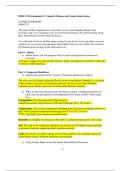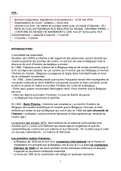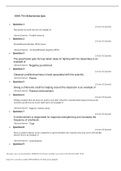General Equilibrium
Outline and Definition – Does the Market Clear?
Many optimising, price taking agents who produce and consume different goods
¿ ¿ ¿
There exists some price vector P > 0 s.t. z i ( p ) ≤ 0 and Σ p i z i ( P ) =0 (Walras’ Law)
¿
o Ie feasible allocation Σ x ki ≤ Σ ω ki . If z i ( p ) <0 ⇒ pi =0 ie excess supply p=0
¿ ¿
All agents are optimising s.t. budget/cost constraints
Assumptions: no frictions, price taking, optimising, production has strictly diminishing
returns (rules out discontinuity in supply)
Limit to competitive markets, look at small number of goods and consumers
A general equilibrium is a set of non-negative prices, and a set of demands and supplies of
households and firms such that each demand or supply is optimal for corresponding
household or firm at those prices, and the resulting excess demands are all non-positive
Formal Expression of Conditions
1. Households maximise utility subject to their budget constraints:
ui ¿
2. Firms maximise profits for all y in the production set
Σ p ¿j y ¿ij ≥ Σ p¿j y ij
3. Equilibrium prices must satisfy p j ≥ 0 ∀ j since negative prices are not possible if goods can
¿
be disposed of at zero cost ⇒ price floor of zero implies if negative excess demand, price
cannot adjust any lower than zero
4. There must be an equilibrium in every market, which requires
z¿j=0 if p¿j >0
j=1,2 , … , n
z ¿j ≤ 0if p ¿j=0
Exchange Economy
¿ ¿ ¿ ¿
Eqbm is pair ( x , p ) s .t . Σ xi ( p , p ω i ) ≤ Σ ωi ie demand ≤ endowment / supply
Excess demand z ( p )=Σ x i ( p , p ω i) −ω i ≤ 0 in eqbm
p ⋅ z ( p )=0 ∀ p ⇒ Walras’ Law, so if n−1 markets clear, nth must too
Model of Exchange
Agents A and B consume goods x 1 and x 2; they obey our above assumptions
A max u ( x ) s . t . p x a ≤ p ω a; B max u( x ) s . t . p x b ≤ p ω b
j=k j 1 k
Recall p xi =Σ j=1 p j xi = p1 xi +⋯ pk x i ⇒ max ui s .t . p x i ≤ p ωi
Edgeworth Box
Allows us to depict endowments and preferences – can see feasible allocations
¿
Markets
Positive don’tforclear
excess demand goodinitially
1 – can't have z i ( p ) >0 Negative excess demand for good 2
so can't be eqbm
, Prices adjust and markets clear
Change in relative prices causes budget constraint to pivot about endowment point
Can just adjust one price until its market clears – Walras states that other one will clear
automatically
( x ¿ , p ¿ ) s .t . x a + x b=ωa +ω b
Proof of Eqbm – Fixed Point Theorem
1 1 1 1 1
Define z ( p ) =( x a ( p )−ω a ) + ( x b ( p )−ωb ) ⇒ Walras’ Law,
for any p, p ⋅ z ( p )=0
Proof from adding up budget constraints
Fix p2=1 and vary p1 ⇒ if one market clears, both will
clear
o x and y homogenous degree zero in prices, so z is
k
too ie λ z i ( p 1 , … , pn )=z i ( λ p1 , … , pn ) ⇒ k=0
1
So can always normalise prices: λ=
p1
We require convexity production, boudnedness of supply, closedness of supply, and
continuity of the production functions
If above satisfies then there will be some mapping of the set of excess demands onto itself ie
2 1
f : z ( p ) → z ( p)
If excess demand for good 2, is a function of excess demand of good 1, which are both
functions of prices, then holding one excess demand constant, normalising one price, and
varying the other price will allow location of a fixed point – where the two excess demands
are equal to zero
Existence of Eqbm
Eqbm exists if preferences are continuous, monotonic, and convex, and ω ≥ 0
The set of prices is bounded by p ≥0 below but is unbounded above
Require assumption that there is always a finite excess demand for a good whose price is zero
– otherwise would be some households who sell their endowments for positive prices but buy
the goods whose price is zero so it is possible that their demand for these free goods is zero
Breaks down under IRS as supply unbounded
Badly behaved preferences give discontinuous excess demand function – or goods only in
discrete quantities
Price taking assumption unreasonable – but would imply that even if individuals have
discontinuous demands, economy’s Z ( p ) continuous
o No sense of how markets work, how prices are set, what goods are exchanged when
or where, absence of money to measure numeraire price
Require awareness of all prices for every good – in reality this is undermined by price
differences for same good in different places ⇒ unrealistic for consumers to know
Model is static: uncertainty regarding future market situation and inability to make accurate
forecasts would undermine eqbm
Violating ω ≥ 0 / agent endowed with good they will consume at any price
Empirics of markets in a single commodity support Walrasian eqbm concept as subjects learn
what prices should be through repeated market operation
Walras’ Law
If individual BCs bind, then for any P , Z=0
Outline and Definition – Does the Market Clear?
Many optimising, price taking agents who produce and consume different goods
¿ ¿ ¿
There exists some price vector P > 0 s.t. z i ( p ) ≤ 0 and Σ p i z i ( P ) =0 (Walras’ Law)
¿
o Ie feasible allocation Σ x ki ≤ Σ ω ki . If z i ( p ) <0 ⇒ pi =0 ie excess supply p=0
¿ ¿
All agents are optimising s.t. budget/cost constraints
Assumptions: no frictions, price taking, optimising, production has strictly diminishing
returns (rules out discontinuity in supply)
Limit to competitive markets, look at small number of goods and consumers
A general equilibrium is a set of non-negative prices, and a set of demands and supplies of
households and firms such that each demand or supply is optimal for corresponding
household or firm at those prices, and the resulting excess demands are all non-positive
Formal Expression of Conditions
1. Households maximise utility subject to their budget constraints:
ui ¿
2. Firms maximise profits for all y in the production set
Σ p ¿j y ¿ij ≥ Σ p¿j y ij
3. Equilibrium prices must satisfy p j ≥ 0 ∀ j since negative prices are not possible if goods can
¿
be disposed of at zero cost ⇒ price floor of zero implies if negative excess demand, price
cannot adjust any lower than zero
4. There must be an equilibrium in every market, which requires
z¿j=0 if p¿j >0
j=1,2 , … , n
z ¿j ≤ 0if p ¿j=0
Exchange Economy
¿ ¿ ¿ ¿
Eqbm is pair ( x , p ) s .t . Σ xi ( p , p ω i ) ≤ Σ ωi ie demand ≤ endowment / supply
Excess demand z ( p )=Σ x i ( p , p ω i) −ω i ≤ 0 in eqbm
p ⋅ z ( p )=0 ∀ p ⇒ Walras’ Law, so if n−1 markets clear, nth must too
Model of Exchange
Agents A and B consume goods x 1 and x 2; they obey our above assumptions
A max u ( x ) s . t . p x a ≤ p ω a; B max u( x ) s . t . p x b ≤ p ω b
j=k j 1 k
Recall p xi =Σ j=1 p j xi = p1 xi +⋯ pk x i ⇒ max ui s .t . p x i ≤ p ωi
Edgeworth Box
Allows us to depict endowments and preferences – can see feasible allocations
¿
Markets
Positive don’tforclear
excess demand goodinitially
1 – can't have z i ( p ) >0 Negative excess demand for good 2
so can't be eqbm
, Prices adjust and markets clear
Change in relative prices causes budget constraint to pivot about endowment point
Can just adjust one price until its market clears – Walras states that other one will clear
automatically
( x ¿ , p ¿ ) s .t . x a + x b=ωa +ω b
Proof of Eqbm – Fixed Point Theorem
1 1 1 1 1
Define z ( p ) =( x a ( p )−ω a ) + ( x b ( p )−ωb ) ⇒ Walras’ Law,
for any p, p ⋅ z ( p )=0
Proof from adding up budget constraints
Fix p2=1 and vary p1 ⇒ if one market clears, both will
clear
o x and y homogenous degree zero in prices, so z is
k
too ie λ z i ( p 1 , … , pn )=z i ( λ p1 , … , pn ) ⇒ k=0
1
So can always normalise prices: λ=
p1
We require convexity production, boudnedness of supply, closedness of supply, and
continuity of the production functions
If above satisfies then there will be some mapping of the set of excess demands onto itself ie
2 1
f : z ( p ) → z ( p)
If excess demand for good 2, is a function of excess demand of good 1, which are both
functions of prices, then holding one excess demand constant, normalising one price, and
varying the other price will allow location of a fixed point – where the two excess demands
are equal to zero
Existence of Eqbm
Eqbm exists if preferences are continuous, monotonic, and convex, and ω ≥ 0
The set of prices is bounded by p ≥0 below but is unbounded above
Require assumption that there is always a finite excess demand for a good whose price is zero
– otherwise would be some households who sell their endowments for positive prices but buy
the goods whose price is zero so it is possible that their demand for these free goods is zero
Breaks down under IRS as supply unbounded
Badly behaved preferences give discontinuous excess demand function – or goods only in
discrete quantities
Price taking assumption unreasonable – but would imply that even if individuals have
discontinuous demands, economy’s Z ( p ) continuous
o No sense of how markets work, how prices are set, what goods are exchanged when
or where, absence of money to measure numeraire price
Require awareness of all prices for every good – in reality this is undermined by price
differences for same good in different places ⇒ unrealistic for consumers to know
Model is static: uncertainty regarding future market situation and inability to make accurate
forecasts would undermine eqbm
Violating ω ≥ 0 / agent endowed with good they will consume at any price
Empirics of markets in a single commodity support Walrasian eqbm concept as subjects learn
what prices should be through repeated market operation
Walras’ Law
If individual BCs bind, then for any P , Z=0










